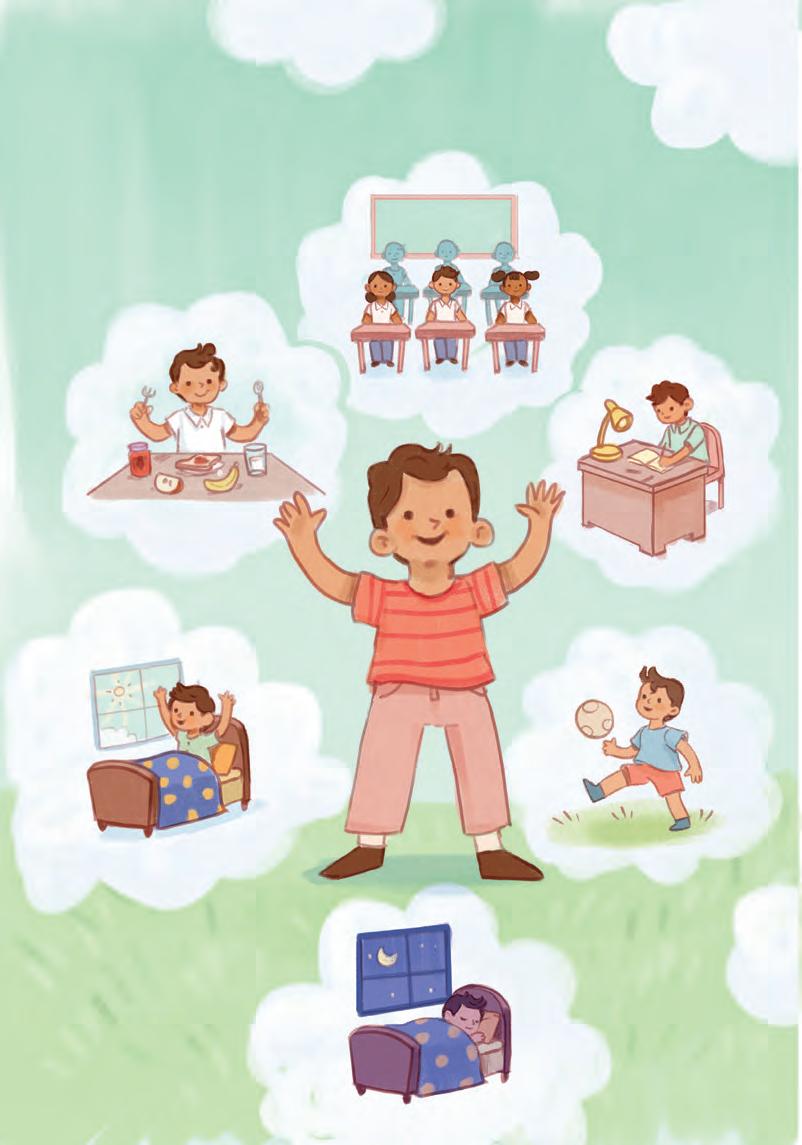











Times have changed. Today is not the time of memorising and copying. Students must be enabled to think for themselves and articulate their thoughts well. They should be able to participate meaningfully and confidently in dayto-day activities – whether it be buying groceries, registering a formal complaint, or voicing opinions freely. A problem-solving attitude, critical outlook, scientific temperament and creativity are nonnegotiable skills in the 21st century.
The National Education Policy 2020 talks about technology playing an important role in improving the learning outcomes and learning experiences of children. With the growing penetration of the internet and the easy availability of smartphones and other electronic devices, both parents and teachers can participate in and supervise children's learning through various online apps, quizzes, videos, e-books, educational games and so on. In a nutshell, digital learning has the potential to impact on what children learn and how they learn.
Aakash Chowkase
In the post-Covid world, more than ever before, the parents' role is being seen as pivotal to children's growth and learning. The National Education Policy 2020 released by the Government of India, recognises parents as equal partners in their children's education. At home, it is important for caregivers to create a safe, engaging and positive environment for children to learn, apply themselves and have fun. Parents can also engage actively with children around their homework, curricular and co-curricular activities and projects.
NEP 2020 acknowledges the multilingual reality of India and asserts that the bridge of home language or other familiar language is absolutely crucial for children in the foundational years, not only to help them to comprehend basic subjects, but also to acquire additional languages like English. Thus, the needs-based and systematic use of learners' home languages should be encouraged in the classrooms, along with an anxiety-free, purpose-oriented and input-rich environment.
Aparna Dixit Head of Content and Research, Centre for Learning Resources
 Ms Sonia Kumari Assistant Professor, Kamala Nehru College, University of Delhi
Dr
Post-doctoral Research Fellow, University of California, Berkeley, USA, Department of Psychology
Ms Sonia Kumari Assistant Professor, Kamala Nehru College, University of Delhi
Dr
Post-doctoral Research Fellow, University of California, Berkeley, USA, Department of Psychology
Thanks to globalization and the emergence of technologies, international boundaries have become blurred. English, to a high degree, is a commonly understood medium of communication. It is one of the key tools that students need to perform well today and in the future. According to a global study, while recruiting, 98.5% of employers implicitly or explicitly assess a candidate’s English communication skills! There is therefore a growing demand for English communication skills, because it empowers people and enables them to lead a better life. Functional communication skills, involving aspects of LSRW (listening, speaking, reading and writing), are central to knowledge acquisition, children’s intellectual, social and emotional growth, and life-long learning.
Specifically, strong listening and speaking skills are not only vital in the overall language learning process, but also lead to better reading and writing skills. Yet, these foundational skills tend to be neglected in schools due to the high pupil-teacher ratio, lack of oral language-focused assessment, and most importantly, a lack of systematic and allocated practice time for these skills within the classroom.
Aligned with NEP 2020, NCERT learning outcomes and standardized to CEFR (Common European Framework for Reference) levels, Uolo Speak is a hybrid learning program that focuses on building, applying, practising, and assessing these core language skills.
First, through this book as one of the components of the program, the English classroom becomes an avenue to hone functional speaking skills in real time. The teacher-led activities give learners the opportunity to undertake high-quality, level-appropriate, and experiential activities that help to build confidence and expression in English.
Second, the mobile interface of the product ensures consistent practice of functional LSRW skills. These exercises go beyond traditional question types and employ cutting-edge technology to enable learning and generate instant feedback. For instance, learners practise speaking with Al (artificial intelligence), as if conversing with a real person!
Third, Uolo Speak assessment can be conducted by the school in sync with their academic calendars. The assessment is evaluated by Uolo’s English specialists to give performance report and feedback.
Finally, the reporting methodology used in the above three program components, generates a skill growth chart against CEFR levels for each learner, class and the school. Educators can then clearly identify learners who are reaching, meeting, and exceeding the level requirements, and support them accordingly.
Uolo Speak is a powerful, exciting, and unique experience for learners and teachers. It represents a real life and results-oriented approach to develop essential 21st century functional English skills.
Wishing all teachers, parents, and learners lots of fun and joyful experiences as you embark upon this exciting journey with Uolo Speak.
Dr Laraine O'Connell
D. Litt., English, North West University, South Africa
I am a veteran English teacher and lecturer, with a great love for English and for teaching. I have taught English and trained teachers over many years. I live in South Africa and it is a wonderful experience working with a company promoting the learning of English in India.
“In the 21st century, language teaching must go beyond traditional approaches and must aim to enable students to use language skills in real-life contexts for a wide variety of purposes.” (NEP, 2020)
According to Vygotsky and Krashen’s theory of second language teaching, language acquisition happens best when learners are engaged in purposeful and meaningful tasks in an anxiety-free, non-judgmental, communication-oriented, input-rich, supportive and stress-free environment, along with a lot of scaffolding practices. (D. Krashen, 1988) Such approach to second-language teaching is also greatly highlighted by the NIPUN Bharat Mission document and NEP 2020. (NIPUN BHARAT, 2021; NEP, 2020)
In this context, the Conversations series and the learning activities designed in it can play a crucial role in creating an input-rich environment, employing diverse avenues for consistent practice in a fear-free and non-judgemental setting, coupled with real-time feedback.
The book also follows the model of ‘Gradual Release of Responsibility’ (GRR), a teaching and learning model that has been widely recommended by the NEP 2020, educational researchers, and practitioners all over the world for its effectiveness in promoting student engagement and deep understanding of content and skills (Pearson & Gallagher, 1983; Duke & Pearson, 2002). Through this model, learners are supported to become independent learners. In this instructional model, the teacher initially takes on the majority of the responsibility for learning, providing explicit instruction and modelling of skills. As learners begin to grasp the content and skills, the teacher gradually shifts the responsibility to them, facilitating a guided practice and a collaborative learning experience. Finally, the learners take full ownership of their learning through independent practice and the application of the skills they have acquired or concepts that have been taught to them.
Following a similar approach, Conversations series offers three core instructional models that are used in every period for building English speaking in learners. They are:
Listen Echo Express and Repeat (E&R)
In this instructional model, the teacher simply reads aloud and models the correct speaking (of stories, presentations, responses) in front of learners. This helps learners receive accurate input for target language and also engage with and understand the content better. Such an input-rich environment makes learners familiar and comfortable with English.

In this instructional model, learners simply repeat English presentations, responses and sentence constructions after the teacher, and try to imitate correct content, pronunciation, flow and expression. Such practice instils a lot of confidence among learners and provides them the required support to be able to speak in English correctly and independently.
In this instructional model, learners follow a speaking cycle, as enumerated below:
1. The teacher asks a question or gives a speaking stimulus.
2. Several learners share their independent responses one after the other.
3. The teacher summarises or rephrases each learners’ response in correct English, if needed.
4. All learners repeat after what the teacher summarises or rephrases, in correct English, and using adequate expression.
The E&R cycle, in this way, not only allows learners to think freely and express independently in an anxiety-free environment, but also allows for the teachers’ intervention in a need-based manner to reinforce English speaking.
To sum it up, this series has been created with a view to do away with the fear of speaking in English among learners, making its fluency a definite possibility in their lives and allowing them to express themselves confidently in real-world situations.
1 Meetings and Greetings Greeting others
2 Listen and Do Simple instructions
3 Magic Words Polite expressions
4 Making Requests
5 About Myself
6 My Family and Friends
Making requests
Talking about oneself
Talking about family and friends
Greet others
Respond to greetings
Follow simple action commands
Say simple action words to get something done
Use polite expressions in day-to-day interactions
Respond to polite expressions
Make simple requests
Respond to requests
Understand simple questions about self
Respond to basic questions about self
Understand simple questions about family and friends
Respond to basic questions about family and friends 7
My Daily Routine
Sharing daily routine
Understand simple questions about daily routine
Respond to basic questions about daily routine 8
Let Me Tell You!
Share an experience in short
Understand simple questions about an experience Answer simple questions about an experience 9
Let Us Talk
Participate in simple conversations
Understand simple questions during a conversation Respond to simple questions in words / phrases
In order to ensure participation of the maximum number of learners during the classroom presentations and to keep the surprise element going, you can try the following quick games for inviting learners to participate:
• Randomly pick the learner’s name written on chits / ice cream sticks / playing cards.
• Ask the learners to write code names for themselves on a chit. Randomly pick the chit from the jar and ask who it belongs to.
• Call out the roll number randomly.
• Say some unique identification markers, e.g. the one who is carrying a blue water bottle, the one who has a red bag, the one who was born in the month of March, the one whose birth date is 15, the one who has curly hair, the one who has two ponies, the one who was born on the same date on which the lesson is being taught, the one who has the same roll number as the date when the lesson is being taught.
• Throw a ball of paper or a plastic ball and give an opportunity to the one who catches it.
• Throw a ball of paper or a plastic ball and give an opportunity to the person who is sitting next to the one who catches it.
• Sing a song / recite a poem while students swiftly pass an object from one to the other. The one who is holding it when the song/poem ends, has to present.
• After their presentation, each student invites the next presenter.
• Open a book randomly at a page. Call out that (roll) number for presentation.
• Pick any letter flashcard from a pile of flashcards. Choose the one whose name starts / ends with that letter.
• Pick any learner’s identity card / passport size photograph / notebook placed upside down on a table. Call that student for a presentation.
• Roll a dice once to call out a single digit (roll) number, or roll a dice twice to call out a double digit (roll) number for presentation.
• At the count of three, the learners as well as the teacher show a number from 1-10 using their fingers. The learner whose number matches with the teacher’s will be invited to present.
• Play stone, paper, scissor with the whole class. Invite those students first whose action matches yours.
• At the count of three, the teacher as well as the learners will shows a colour flashcard. The learners whose colour matches with the teacher’s is invited to present first.
About the Chapter: Through this chapter, learners will develop the skill of greeting others.


Listening Speaking Outcomes: Learners will be able to: • greet others.
• respond to greetings.
Say: Welcome to the Speak class. Today, we will read Chapter 1—Meetings and Greetings.
Instruct: Look at the cover picture for one minute. Observe the things that you see in the picture.

Initiate a discussion as per the suggested questions. Follow the E&R cycle.
1. How many children do you see in the picture? (I can see four children in the picture.)
2. What are the two girls saying in the picture? (One girl is saying, “Hi”. The other girl is saying, “Hello”.)
3. Where do you think they are? (They are at a fair.)
Read aloud/Play a model description of the cover page 2–3 times with expression.

Say: In this picture, we can see two girls. They are with their parents. They greet each other. They wave at each other. One girl says, “Hello”. The other girl says, “Hi”.
Instruct: Repeat each line after me.
If learners struggle, break down the sentences into short but meaningful chunks for repetition. For example: In this picture / we can see / two girls.
Say: You just heard the word greet while listening to me talk about the cover page. Let us learn more about it.
Read aloud the word, its meaning and the example sentences.
Word greet
Meaning words we use when we meet someone
Sentences I greet my parents, “good morning” every day in the morning. / I greet my friend Sonal. I say to her, “Hi!”. / I greet my teacher every day.
Instruct: Repeat the word after me—greet.
Instruct: Repeat the meaning after me—words we use when we meet someone.
Instruct: Repeat the sentence after me—I greet my parents, “good morning”, every day in the morning.
Instruct: Now, why don't you make some sentences with the word greet and tell them to me?


































































































































































About the Chapter: Through this chapter, learners will develop the skill of sharing their daily routine.


Listening Speaking Outcomes: Learners will be able to:
• understand simple questions about their daily routine.
• respond to basic questions about their daily routine.
Say: Welcome to the Speak class. Today, we will read Chapter 7—My Daily Routine
Instruct: Look at the cover picture for one minute. Observe the things that you see in the picture. Initiate a discussion as per the suggested questions. Follow the E&R cycle.
1. What do you see in the picture? (I see a boy doing different things.)

2. How many things is the boy doing? (The boy is doing six things.)
3. What are the six things the boy is doing? (The boy is waking up, eating breakfast, studying, doing his work, playing and sleeping.)
4. Do you think that the boy does these things every day? (Yes, I think that the boy does these things every day. / No, I do not think that the boy does these things every day.)
Read aloud/Play a model description of the cover page 2–3 times with expression.

Say: This is a picture of a little boy. It shows the boy’s daily routine. He wakes up early in the morning. Then, he eats breakfast. He goes to school. He completes his homework and then goes to play. At last, he sleeps at night.
Instruct: Repeat each line after me.
If learners struggle, break down the sentences into short but meaningful chunks for repetition. For example: He / completes / his homework / and then / goes to play.
Say: You just heard the word routine while listening to me talk about the cover page. Let us learn more about it.
Read aloud the word, its meaning and the example sentences.
Word routine
Meaning something that we do every day in the same way and at the same time Sentences I pack my school bag every night as a routine. / I wake up early every morning as my routine.
Instruct: Repeat the word after me—routine.
Instruct: Repeat the meaning after me—something that we do every day in the same way and at the same time.
Instruct: Repeat the sentence after me—I pack my school bag every night as a routine.
Instruct: Now, why don't you make some sentences with the word routine and tell them to me?















































































The 'Conversations' book follows a unique spiralling approach that systematically builds language skills and enables children to express themselves verbally in real-world situations, thus preparing them for the needs of the 21st century world. Each chapter focuses on building specific and age-appropriate English language competencies by weaving together activities that are contextual, experiential, joyful, and research-based.

• Activity-based Learning: The book offers joyful and experiential activities that build English communication competencies.
• Texts as per NEP 2020 themes: The book has exciting and stimulating texts that pave the way for English communication activities.
• Tech Integration: The book works in sync with the digital world, where various other activities and projects are undertaken. Learner outputs are evaluated through an AI-based speech recognition engine.
• Assessment of Speaking & Listening as per CEFR: The program includes special assessment that allows systematic reporting on growth of English language skills as per the CEFR.


• Teachers’ Manual: The book is complemented by the Teachers’ Manual that enables teachers to conduct each session effectively.
Uolo partners with K-12 schools to provide technology-based learning programs. We believe pedagogy and technology must come together to deliver scalable learning experiences that generate measurable outcomes. Uolo is trusted by over 8,000 schools with more than 3 million learners across India, South East Asia, and the Middle East.